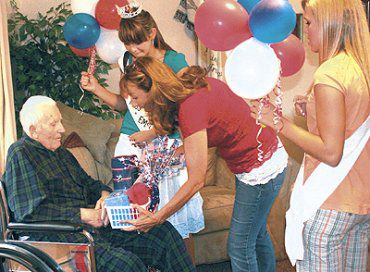Clyde Ray Cox, 98, is the oldest living World War II veteran in Carbon and Emery counties; he served his country with distinction. Clyde celebrated his 98th birthday on July 31. His children treated him to a birthday party. Miss Emery Holly Damron and first attendant Allie Stokes came to the party to greet Cox. They brought him a gift and expressed their appreciation for his service in the military. Damron was recently crowned Miss Emery and her platform is military families and giving them the support they need while their loved ones are serving in the military.
Clyde was born July 31, 1910 in Fairview, Utah to Lyman Ray and Anna Dora Christensen Cox and is the oldest of seven children. Before and after the war, Clyde worked as a farmer and also mined for the American Fuel Company. He is known for having a witty sense of humor and being an exceptionally hard worker.
Clyde was drafted into the army in June 1942 and served until late 1945, achieving the rank of Staff Sergeant. Cox was a Ranger qualified member of an Intelligence and Reconnaissance platoon in the 321st Regimental Combat Team, 81st Infantry “Wildcat” Division. He was initially inducted into the service at Fort Douglas in Salt Lake City after which he was sent to Camp Rucker, Ala. for training with his division. At Camp Rucker, Clyde was quickly promoted to non-commissioned officer status and was selected, along with other highly qualified soldiers, to attend the Division’s Ranger school where he was taught advanced infantry skills such as infiltration, demolition, raiding, sniping, and hand-to-hand combat techniques.
From 1942-1944 Clyde trained in Alabama, Tennessee, California and Hawaii before being sent to fight the Japanese in the Pacific theater of operations.
Clyde first entered combat in the Palau islands located about 500 miles east of the Philippines. The 81st initially invaded Angaur Island in mid-September 1944 and successfully eliminated major Japanese resistance in less than one week. Clyde’s regiment was next sent to assist the 1st Marine Division in bloody fighting on Peleliu Island, a few miles north of Angaur, in late September. There, Clyde’s unit encountered stiff Japanese resistance and several of the men in his unit were killed or wounded.
Clyde received the Purple Heart when he was wounded by shrapnel in his left arm, some of which remains to this day. He was fortunate to survive numerous close calls in combat: a bullet clipped his shirt seam, his rifle was shot from his hands and his helmet was pierced by a bullet, he survived an explosion from a Japanese satchel charge, was nearly shot by snipers, was struck in the shin by a bullet, and shrapnel from a mortar shell cut his boots.
Fighting conditions on Peleliu were horrendous, with the daily temperature reaching 115 degrees. Because Peleliu is a coral island, it made digging foxholes and burying the dead extremely difficult. Following one assault, Clyde was decorated with the bronze star for dragging one of his mortally wounded platoon members out of the line of enemy fire.
More than 60 years after the end of the war Clyde still recalls the names of men he served with, in particular those who lost their lives. He also still remembers how to lay a booby trap with a hand grenade, a technique he often used on Peleliu.
Following combat on Peleliu, Clyde and the Wildcats spent a few months on New Caledonia before being posted on the Philippine island of Leyte in early summer 1945 the same island where General Douglas MacArthur made his famous return to the Philippines.
Clyde and his I
County’s oldest Veteran – Clyde Cox celebrates 98th birthday

"Clyde Cox's daughter Marquita Cox helps present gifts to her Dad from Miss Emery Holly Damron and first attendant Allie Stokes."
